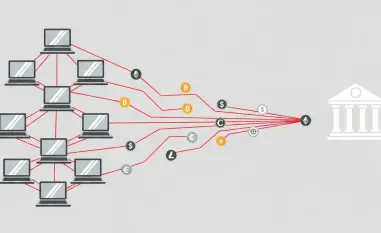The cybercrime ecosystem, particularly the ransomware landscape, has undergone significant changes following proactive law enforcement takedowns in 2024, fundamentally reshaping the broader ransomware environment. These transformative actions by law enforcement agencies have disrupted the operations of prominent ransomware groups, leading to a fragmented and diversified ecosystem. This article delves into the impact of these decisive takedowns and the resulting transformations within the ransomware scene, offering a comprehensive analysis of how the landscape has evolved.
Law Enforcement Achievements in 2024
In 2024, law enforcement agencies across the globe achieved notable successes targeting major ransomware groups, fundamentally altering the cybercrime landscape. Operation Cronos, spearheaded by the UK’s National Crime Agency (NCA), made a substantial impact by focusing efforts on LockBit, a prolific Ransomware-as-a-Service (RaaS) group. This coordinated operation led to the seizure of crucial infrastructure, arrests of individuals associated with the ransomware, and sanctions against the group’s identified operator. In parallel, the FBI’s crackdown on BlackCat/ALPHV in December 2023 culminated in a series of decisive actions, leading to the group’s shutdown by March 2024 after an alleged exit scam.
The immediate effects of these takedowns were profound, significantly disrupting the abilities of these groups to continue their victimizing activities. LockBit and BlackCat had established dominance in the ransomware market through innovative affiliate models, with the ransomware community trusting these models to provide reliable and profitable operations. By undermining their operations, law enforcement introduced a sense of mistrust among affiliates and partners of these ransomware giants. This mistrust caused a fragmented ecosystem characterized by increased entropy, with new groups rapidly emerging to fill the void left by these prominent takedowns. Affiliates, now wary of established RaaS models, turned to less known and burgeoning entities out of necessity.
Fragmentation and Diversification of the Ransomware Landscape
The successful takedowns of LockBit and BlackCat led to a more fragmented and diversified ransomware landscape, challenging the previously concentrated power held by a few dominant groups. Despite a significant 30% increase in the number of active ransomware groups, the number of victims listed on leak sites remained relatively stable. This indicates that more groups are now listing a comparable number of victims, suggesting a shift to a more diverse and less concentrated ransomware ecosystem. The distribution of victims across these myriad groups highlights the evolution of the ransomware landscape into a complex, multifaceted domain where smaller, agile groups are preying on organizations.
Emerging groups such as Qilin and RansomHub have notably benefited from the disruptions caused by the law enforcement takedowns. Qilin’s activities surged following the dismantling of LockBit and BlackCat, taking advantage of the power vacuum. Similarly, RansomHub began listing victims shortly after the LockBit takedown, displaying a steady increase in its victim count month-over-month. The Change Healthcare ransomware attack serves as a case in point, exemplifying how RansomHub capitalized on these disruptions. Initially, Change Healthcare was listed on the new BlackCat leak site, with a ransom demand leading to a $22 million payment. When BlackCat’s operations subsequently closed, the responsible affiliate relisted Change Healthcare on RansomHub, underscoring the fluidity and opportunism prevailing in the ransomware landscape.
Rise of Independent and Non-Affiliated Operators
The fragmentation of the ransomware ecosystem has also given rise to a surge in ransomware intrusions conducted by non-affiliated, independent attackers. These intrusions exhibit distinct characteristics, such as unbranded ransom notes devoid of the typical Tor-based negotiation portals or leak sites. Instead, attackers have reverted to more direct communication methods, employing email addresses or private Tox chat channels to interact with victims. This shift marks a departure from traditional methods, reflecting the adaptive strategies employed by cybercriminals in a rapidly evolving landscape.
Unlike the more generic ransom notes used by established groups, these intrusions often include detailed information about the compromised data. This approach is designed to establish credibility with victims quickly and avoid prolonged negotiations. By providing specific details about the stolen data, attackers aim to exert psychological pressure on their targets, pushing them toward expedited ransom payments. This opportunistic behavior highlights the inherent fluidity within the ransomware landscape, as former affiliates and new independent operators adjust to the changing environment disrupted by law enforcement actions.
Continued Threats and Evolving Tactics
Despite the successes achieved by law enforcement in disrupting prominent ransomware groups, ransomware remains an enduring and significant threat to organizations worldwide. The fundamental tools and tactics employed by ransomware operators have not seen drastic changes. The most common access vectors continue to be stolen credentials and exploited vulnerabilities in internet-facing services, methods that remain difficult yet crucial for organizations to defend against. This persistence underscores the resilience of ransomware operators who continually adapt their techniques to bypass security measures.
Modern ransomware operations have shown a propensity to rely more on older tools, frameworks, and legitimate applications than on custom-developed malware. This strategic shift allows them to exploit existing software and tools that are harder for security teams to detect and prevent. The continued use of established tactics, rather than novel innovations, underscores the resilience and adaptability of the ransomware threat. Organizations must therefore remain vigilant in their cybersecurity postures, employing comprehensive security mechanisms to defend against these persistent threats.
Implications for Organizations and Best Practices
The cybercrime ecosystem, especially the ransomware landscape, has seen major changes due to proactive law enforcement actions taken in 2024. These impactful interventions have significantly reconfigured the overall ransomware environment. Law enforcement agencies’ strategic takedowns have disrupted the activities of major ransomware groups, causing the ecosystem to fragment and become more diversified. This article explores the consequences of these bold actions and the subsequent changes within the ransomware scene. It provides a thorough analysis of how the landscape has shifted, examining the effects of disrupting influential groups and how this has led to new dynamics in the cybercrime community. By understanding these transformations, one can gain a clearer picture of how the ransomware threat has evolved and how efforts to combat it have adapted. This comprehensive look at the shifts in the ransomware world highlights the ongoing challenges and responses shaping the fight against cybercrime.













